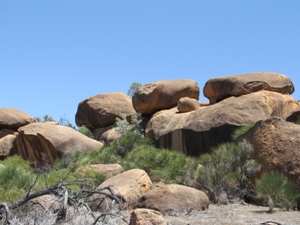Australia So Much to See


Yorkrakine Rock: Situated 25 kilometres north of Tammin, this granite outcrop of two adjoining sections, reaches 341 metres above sea level and covers 160 hectares. The flora around its base forms an important flora and fauna rreserve.
This picnic spot has toilet facilities but camping is not permitted.
A valley runs between the semi divided rocks which are linked by a bridge-like band of rock.
The name Kellerberrin is Aboriginal, and is derived from the name of a nearby hill. The hill was first recorded as "Killaburing Hill" by an explorer in 1861, but in 1864 the explorer C C Hunt recorded it as Kellerberrin Hill. One source claims that Kellerberrin is the name for the fierce ants that are found in the area, while another gives it as meaning "camping place near where rainbow birds are found"- "kalla means camping place or place of, and "berrin berrin" is the rainbow bird.
This wheatbelt town is on the Great Eastern Highway 58 kilometres west of Merredin. Sheep graziers moved into the area in the 1860s, and the town is now central wheat growing and industries such as silo manufacturing, rural engineering and agencies, spraying and seed cleaning services are based on the farming needs.
At first a station when the rail line from Northam to Southern Cross was opened in 1895, and a townsite was surveyed. The town of Kellerberrin was gazetted in 1901.
The Agricultural Hall was built in 1897, and in parliament, the member for Yilgarn the Hon. C J Moran, is reputed to have said he had no objection to the government of the day spending 250 pounds building a hall where only "a man, his dog and a dead kangaroo existed" but that he thought the money would be better spent in the goldfields (his electorate).
Forty nine kilometres west of Bruce Rock, Kokerbin Rock lays claim to being the third largest monolith in Australia. Kokerbin Rock covers nine hectares and rises 122 metres above the surrounds. Kokerbin is yet another rock with colourful wave facets.
The track which four wheel drivers accessed the rock to drive to the top has been blocked off, and driving on the rock is no longer permitted.
This stone well is at least twenty metres deep and three metres in diameter. It was constructed by hand in the early 1920-30’s. Rocks were levered into the soil to line well walls to create a water supply for livestock.
We met the Great Eastern Highway at Tammin. Tammin was one of the original stations when the railway to Southern Cross opened in 1895 and the townsite was gazetted in 1899. Tammin is an Aboriginal name derived from the nearby Tammin Rock.
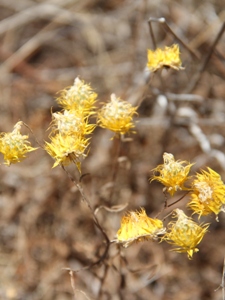
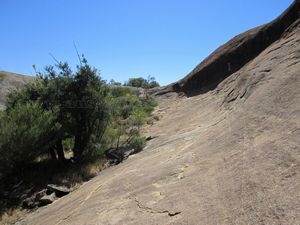
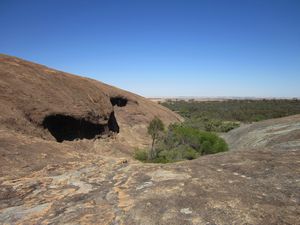
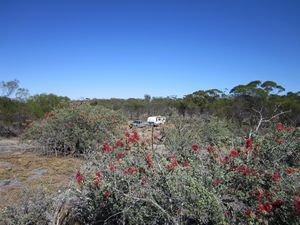
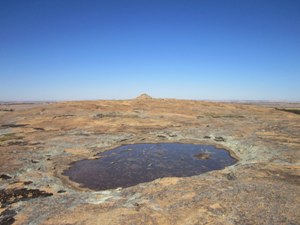
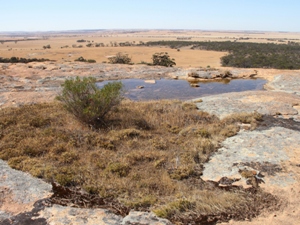
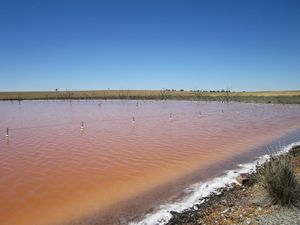
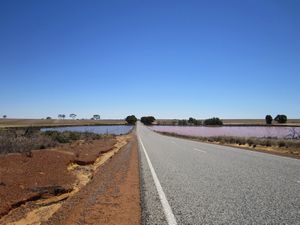
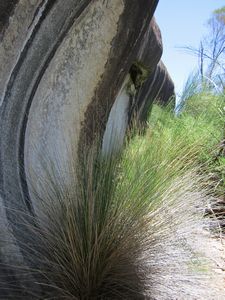
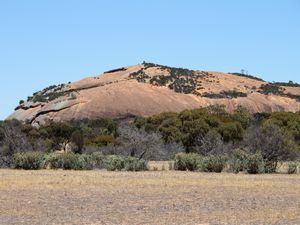
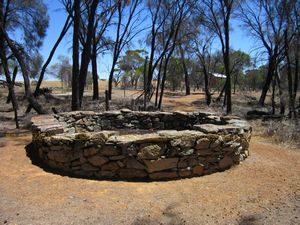
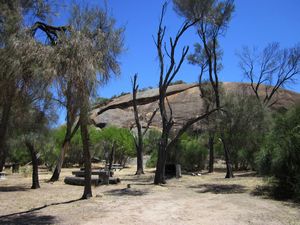
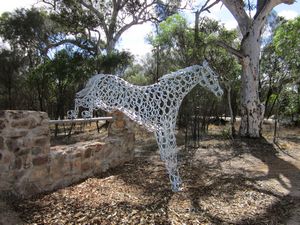
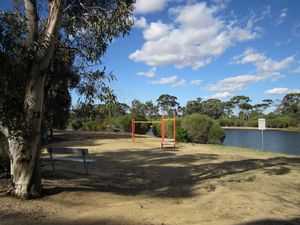
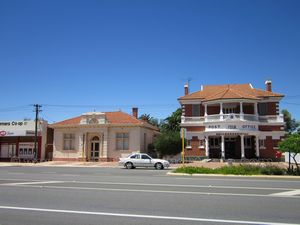
Ten kilometres east of Quairading, the road divides a small lake. The water to the north of the road is clearly pink, whereas to the south the water remains blue-green. The pink colour is seasonal and is believed to be caused by bacterial action in the salt at the base of the lake. When the lake becomes highly saline in summer, the heat and light create ideal conditions for the colour to develop. The pool on the south side of the does not have the same high salinity as the pink lake on the north side of the road. Quairading takes its name from the nearby Kwerading Spring and the Aboriginal meaning may be "home of the bush kangaroo"- "quara".
Pink and blue: A two tone lake near Quairading
Cuballing
This amazingly well proportioned horse was created by Cuballing Shire staff member Tim Bradford. He is also the man who created the ploughman and his dog (at the intersection of the highway and Campbell Street). The horse is the new entry statement as Cuballing is home to the new Equestrian Centre for this area. There will also be another horse sculpture erected as you come into Cuballing from the Popanyinning direction. Cuballing was named after nearby Cubballing Pool and the Aboriginal meaning is now obscure.
Yornaning Dam is a recreation area alongside a dam originally constructed in 1886 to provide water for steam trains. The dam was restored by the Shire and community in 1993 for recreation purposes as it has silted up. There is now a picnic area, playground and pit toilets with a roomy woodland parking area.
Approximately halfway between Cuballing and Popanyinning and accessed from the Great Southern Highway ten kilometres north of Cuballing by a road signed to Yornaning Dam and the Dryandra forest. Cuballing is fourteen kilometres north of the wheatbelt centre of Narrogin.
Harvesting to the north of Tammin.
The present post office was the second post office to be built in Kellerberrin, being built in 1912 and opened in 1913 and has been used for that purpose ever since. The building next to it was the Bank of New South Wales. The sign Established 1817 at the top of the arch refers to the Bank of New South Wales not this particular branch or building.
There is a drive through long rig parking loop opposite the main shops on the Highway at Kellerberrin, with a toilet block adjacent.
Nine kilometres to the south, just off the Bruce Rock – Quairading Road at the former townsite of Kwolyin, a new free campsite has been created. Flushing toilets, camp kitchen, picnic tables and barbecues (seasonal use only) are provided. Camping is no longer permitted at Kokerbin Rock picnic area. See camp area brochure. See more about location and two photos under Bruce Rock on Free and Low Cost Campsites.
Kwolyin is the Aboriginal name of a nearby granite hill, first recorded by the explorer C C Hunt in 1864 as Qualyin Hill.
Hint: Park at the Old Well picnic area rather than the main picnic area to commence the walk to the top as the climb commences on that side of the rock.
